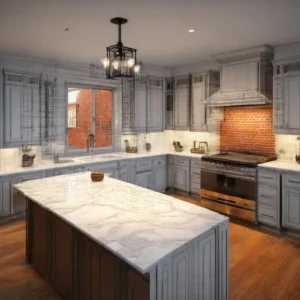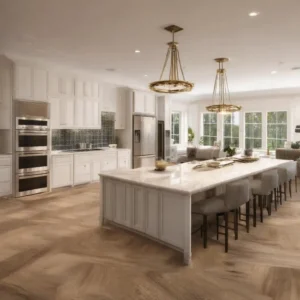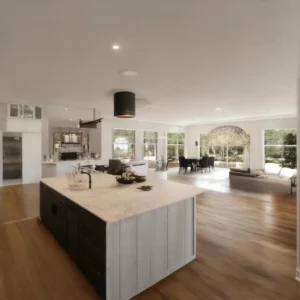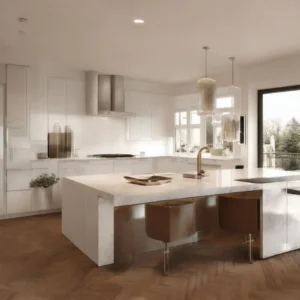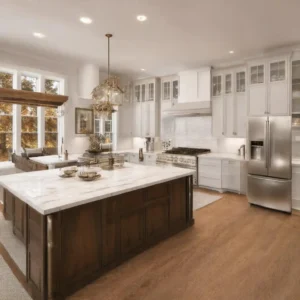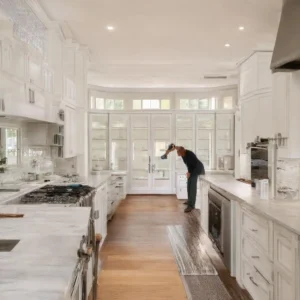A luxury kitchen is more than a beautiful space—it is a finely tuned environment that elevates everyday living, supports effortless entertaining, and stands up to years of use. In St. Louis City and throughout the region—from Chesterfield, Ballwin, Wildwood, Valley Park, and St Charles to Clayton, Creve Coeur, Ladue, Olivette, Overland, Maryland Heights, Richmond Heights, Sunset Hills, Webster Groves, Maplewood, University City, and the broader St Louis area—homeowners are seeking kitchens that reflect refined taste while meeting the practical demands of busy households.
Local preferences trend toward designs that blend timeless character with contemporary convenience: rich natural materials, quiet-close custom cabinetry, chef-level appliances, and layouts that make hosting as enjoyable as weekday meals. The right plan integrates premium finishes with intelligent storage, layered lighting, and smart technology—ensuring your investment delivers long-term value, energy efficiency, and daily pleasure.
Below are seven must-have features that define a truly luxurious kitchen upgrade in St. Louis and its surrounding areas.
The Seven Must-Have Features
1) A statement island with premium surfaces and purposeful seating
The island is the social and functional anchor of today’s luxury kitchens. Opt for generous proportions (often 8–11 feet, where space allows), waterfall edges, and premium surfaces such as quartzite, honed marble, sintered stone, or high-performance quartz. Incorporate a 12–16 inch overhang for comfortable seating, integrated outlets for small appliances, and a built-in charging drawer. Consider dual-height surfaces—durable prep zones paired with a raised serving ledge—to separate cooking from entertaining. In homes from Ladue and Clayton to Ballwin and Chesterfield, a sculptural island with artful pendant lighting instantly sets an elevated tone.
2) Custom cabinetry and intelligent storage
True luxury shows in the details: furniture-grade construction, inset doors, full-extension dovetail drawers, and tailored interior organization. Specify floor-to-ceiling cabinetry to maximize vertical storage; add pull-out pantries, tray and cutting board dividers, spice pullouts, deep drawers for pots, and appliance garages that hide mixers and espresso machines. A scullery or butler’s pantry—ideal for frequent entertainers in Webster Groves, Creve Coeur, and University City—keeps prep and cleanup out of view, preserving the kitchen as a clean, inviting showcase.
3) Professional-grade appliances with robust ventilation
Choose appliances that match your culinary ambitions and the scale of your space: 36–48 inch ranges or induction cooktops, separate column refrigerators and freezers, steam and speed ovens, and panel-ready dishwashers for a seamless look. Pair them with a properly sized, quiet, and powerful ventilation system; local code may require make-up air for higher-CFM hoods, especially in older St. Louis City and Maplewood homes. Add a built-in coffee station, undercounter beverage center, or refrigerated drawers for a hospitality-forward experience—popular in Richmond Heights and Maryland Heights where casual entertaining is frequent.
4) Layered, controllable lighting for mood and precision
Luxury lighting is both art and utility. Combine ambient (recessed), task (under-cabinet and island pendants), and accent lighting (toe-kick and interior glass-cabinet illumination). Aim for high-CRI LEDs (90+) at warm color temperatures (2700K–3000K) to render finishes beautifully. Install dimmers and smart controls to transition from bright prep mode to relaxed evening ambiance. In spaces across Overland, Olivette, and Sunset Hills, thoughtfully layered lighting highlights architectural features and ensures comfortable visibility throughout the day.
5) Luxe materials and enduring finishes
Materials are where refinement meets resilience. Consider full-height slab backsplashes for a seamless, easy-to-clean statement; wide-plank hardwood or large-format porcelain for warmth and durability; and mixed metal accents—unlacquered brass, brushed nickel, or matte black—for visual depth. Premium hardware with solid weight and precise action contributes to a tactile sense of quality. For family-forward kitchens in Valley Park, Wildwood, and St Charles, select finishes that resist stains and scratches while maintaining an elegant aesthetic.
6) Smart technology that simplifies daily life
Incorporate features that discreetly enhance function: touchless or voice-activated faucets, boiling-water taps, smart ovens with guided cooking, leak detection sensors, and app-based appliance monitoring. Under-cabinet outlets and integrated charging keep counters clear. For homes embracing whole-house automation—from Clayton townhomes to Chesterfield estates—connect lighting scenes, shades, and climate to elevate comfort and efficiency without visual clutter.
7) Bespoke design details that personalize the space
Luxury is, above all, personal. Tailor the kitchen with elements that reflect your lifestyle and architecture: a concealed bar or breakfast pantry behind pocket doors, a temperature-controlled wine wall, a custom range hood, a dedicated baking center with marble insert, or a built-in banquette under a window. In Ladue and Clayton, traditional millwork and inset cabinetry honor classic architecture; in University City and Maplewood, clean lines and warm woods can nod to mid-century heritage; in Ballwin, Maryland Heights, and Overland, durable family-centric layouts prioritize easy maintenance without sacrificing style.
Planning, Budgeting, and Visualizing Your Remodel
-
Start with zones and flow: Define prep, cooking, cleanup, storage, and hospitality zones. Provide generous clearances—42 inches for single-cook aisles and up to 48 inches for multi-cook kitchens. Place secondary prep sinks near the island or the range to reduce cross-traffic. Ensure adequate landing zones beside major appliances.
-
Choose the right layout for your footprint: L-shaped with an island offers excellent circulation, U-shaped maximizes storage, and a refined galley can be exceptionally efficient in narrower spaces common in historic St. Louis City homes.
-
Anticipate infrastructure upgrades: Older homes in Webster Groves, Maplewood, and University City may require electrical service increases, new dedicated circuits, or plumbing updates. Plan early for make-up air with high-capacity hoods and confirm floor structure adequacy for stone slabs and large-format tile.
-
Align budget with priorities: Allocate more toward elements that are costly to change later—cabinetry, layout, and mechanical upgrades. Surfaces and fixtures can be value-engineered without sacrificing the overall vision. A realistic contingency (10–15%) helps manage surprises, particularly in renovations of mid-century and pre-war structures.
-
Use professional visualization tools: A complimentary 3D design service is invaluable for comparing island sizes, cabinet elevations, and finish palettes before committing. Seeing proportion and light interaction in renderings helps you fine-tune decisions with confidence and avoid costly revisions during construction.
-
Insist on professional installation and quality assurance: Premium materials achieve their potential only with experienced trades. Look for installers and fabricators who understand tight tolerances, vein-matching on stone, and the subtleties of appliance panel alignment.
Local Insight and Next Steps
Design tastes vary across the metro, but certain principles resonate widely: timeless materials, concealed clutter, intuitive workflows, and a balance of warmth and sophistication. In Chesterfield, Ballwin, and Wildwood, expansive islands and generous sculleries support active households. Clayton, Creve Coeur, Ladue, and Olivette often favor bespoke cabinetry, panel-ready appliances, and refined millwork that complement architectural pedigree. In St Charles, Valley Park, and Maryland Heights, families appreciate durable finishes and smart storage that streamline daily routines. Overland, Richmond Heights, and Maplewood frequently blend character details with modern conveniences, while Sunset Hills, Webster Groves, University City, St. Louis City, and the broader St Louis area prize designs that respect historic context while delivering contemporary performance.
Expressions Remodeling specializes in guiding homeowners through this process with a focus on quality, integrity, and innovation. By pairing top-tier materials with skilled craftsmanship, the team delivers luxurious kitchens that look exquisite and function flawlessly. Clients benefit from personalized design consultations, free estimates, and a complimentary 3D design service that brings ideas to life before work begins—enhancing clarity, aligning expectations, and ensuring the final result reflects your vision.
Whether your goal is a show-stopping island, a chef-caliber appliance suite, or discreet smart features that make everyday life easier, the seven must-have elements above provide a clear framework. Explore combinations that suit your home’s architecture and your lifestyle, then partner with experienced professionals who can translate those priorities into precise plans and impeccable execution. The result is a kitchen worthy of its place at the heart of your home—beautiful, highly functional, and tailored to St. Louis living for years to come.



